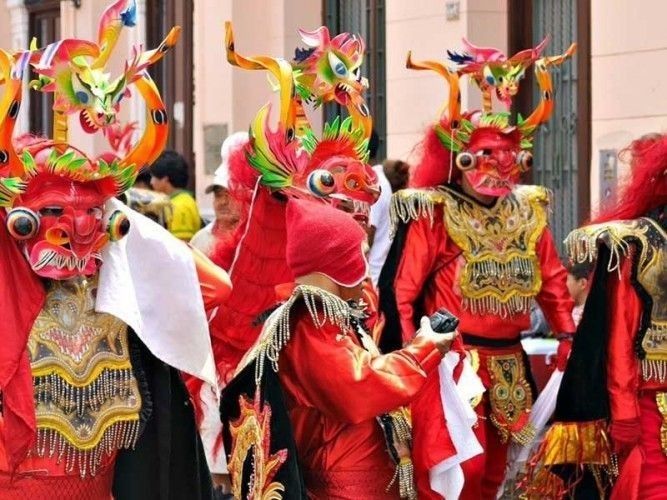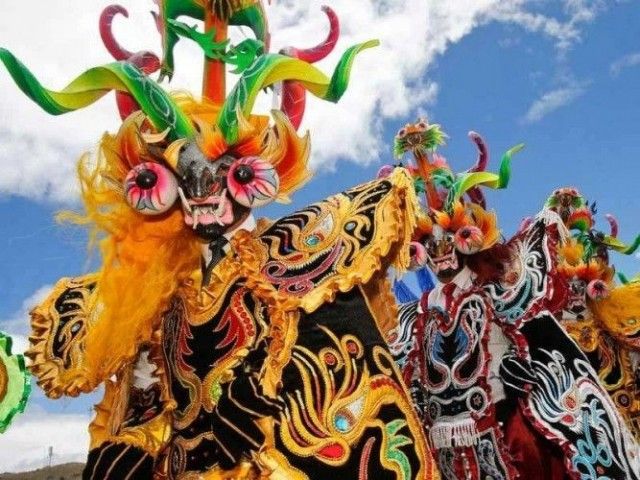Throughout the month of February carnival is celebrated in Peru; a time full of fun, festivities, parades, balloon wars, merged native and catholic traditions, food, music and dancing.
Peruvian carnival – a mixture of traditions from two worlds
Overall, the Peruvian culture is a mixture of ancient indigenous traditions and rites on the one hand and customs and rituals that came to Peru first with the Spanish conquerors and later with African, European and Asian immigrants on the other hand. This circumstance is also reflected in the celebrations of carnival in Peru.
While in ancient Europe bad ghosts and demons were driven out during pagan ceremonies at the end of winter, a tradition which later was adapted by the Catholic church to have a good time before the fasting period begins, ancient Peruvians celebrated around the same time of the year different planting and harvest festivals thanking the gods for a good harvest or praying for good or better times at the end of the southern hemisphere summer.
When the Spaniards colonized Peru, these different and still so similar festivities merged and the very special Peruvian carnival was born. While everywhere in the country you have parades, music, dancing, costumes and food for the carnival celebrations, each region in Peru still has preserved its own carnival traditions and ways to celebrate.
Balloon Wars in Peru
Throughout February, it is very common to have water fights in Peru. Armed with water balloons, water guns and even buckets or hoses, citizens take over the streets, fight water mock battles and wet everything in the way.
While these water games are only recorded since the late 17th century in Peru, they might as well have ancient roots. In medieval Europe, mock battles with wooden sticks and excessive food and alcoholic beverage consumption before the Lenten season were quite common; in the Inca Empire, people paid homage to Pachamama (mother earth) and the fertility goddess with food and water offerings on a special worship day called Dia de la Challa. Interesting here that challa means to sprinkle the earth in Quechua and the day coincides more or less with the European Shrove Tuesday. So, combing these two traditions, today’s by citizens beloved and authorities darned water games might have developed.
The Yunza Ritual
Another very common tradition during carnival season is the age-old yunza ritual, which is also known in some Peruvian regions as cortamonte, umisha, unsha (decorated tree), sacha cuchuy (cutting a tree in the quechua language) or humishas (gift tree). For the festivities, a tree is planted lavishly decorated with presents, colorful ribbons and balloons. First, all residents of the community are dancing around the tree. At one point the dancing stops and a couple tries to cut down the tree with a machete in three strikes. It then passes the machete to another couple, which as well attempts to fell the tree in three strikes and so on. When the tree finally falls, everyone rushes to snatch one of the presents.
And here it’s as well funny to see a similarity to a tradition of the old-world. Even though not taking place during carnival, but rather on May 1st or Pentecost the old Germanic European tradition of erecting and dancing around a nicely decorated tree log called maypole is still celebrated in many countries in Europe, especially Germany and Austria.
The Royal Couple - Carnival Queen and No Carnavalon
In Peruvian carnival communities choose a royal couple, the Carnival Queen and King (Rey Momo), named No Carnavalon. Similar to European carnival, the Queen has her own day (Thursday before Shrove Tuesday) where she and the women are in charge. The King, however, enters the picture usually on Saturday and rules over the carnival parades and symbolizes the time of fun and craziness. To end the carnival season and ring in the fasting period, No Carnavalon, the deceased carnival represented by a boy doll, is burned and his will read on Ash Wednesday.
While during carnival week there are festivities and celebrations throughout the country, the hotspots for the Peruvian carnival are Cajamarca, Ayacucho and Puno.
Carnival in Cajamarca
Named Capital of the Peruvian Carnival, celebrations in Cajamarca are most probably the biggest and most enthusiastic in the country, with festivities following a traditional program throughout the carnival season. The big day of the festivities is carnival Monday, with a huge carnival parade and enormous celebrations.
Carnival in Ayacucho
The carnival in Ayacucho is one of the most authentic and traditional in Peru and was even declared National Cultural Patrimony. In Ayacucho the principal days are carnival Sunday and Monday with a big parade full of decorated carts, dancers, musicians, costumes and masks.
Festival de la Candelaria – Carnival in Puno
Often referred to as the folkloric capital of Peru, Puno hosts the largest cultural festival with parades, music and dance performances, traditional costumes and lots of other activities each year at the beginning of February merging Catholic traditions and age-old Andean customs, rites and symbols.
Find more information on the Carnival of Puno in our article "Festival de la Candelaria".




























